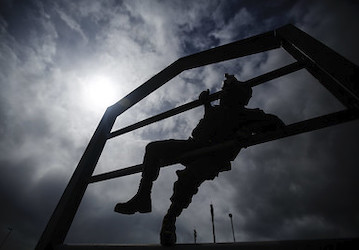A barrier is an obstacle that prevents movement or access, both physically and in the abstract sense. In physical fitness, a barrier is anything that makes it difficult for you to get enough activity or exercise. The most common barriers people list to being physically fit are not having enough time, energy, or motivation, and a lack of social support. These are all barriers to your military fitness. While it’s important to embrace the things that motivate you and make it easy to stay active, identifying and addressing your barriers is critical to removing or working around the things that stand in your way to military wellness.
Identify your barriers
Take some time to make a list of the things that make it difficult or impossible for you to exercise. Are your work days too long to make time? Do your friends or family not support your activity goals? Does it hurt to exercise? Anything that you think might get in the way counts.
Once you have your list, reflect on whether these barriers are real or perceived. Real barriers are things that you need to actually overcome in order to be more active. A perceived barrier is a potential negative aspect of being more physically active. For example, a real barrier could be not having enough time. You might need to modify your schedule to make time to go to the gym. A perceived barrier could be that working out might be painful. You can work around this by identifying which specific activities or exercises actually are painful and finding alternatives.
 Find out how to work out around exercise limitations Learn More
Find out how to work out around exercise limitations Learn More
Know your goals
You might have a running list of SMART goals to maintain your fitness. Now that you have your list of fitness barriers, you can adjust fire and modify some of your goals. It’s okay to recognize that not all barriers can be overcome, and that is a big part of meeting your goals.
How do you overcome obstacles?
Here are a few common barriers to working out and some suggestions for how to overcome them.
Lack of time
If you feel like you don’t have time to commit at least 30 minutes a day for exercise, first take a look at your weekly schedule. Is there anywhere you can carve out some time for workouts? Try to find inefficiencies in your schedule that can be adjusted, or times that you spend sitting that could be better spent exercising. Also look for creative ways to add physical activity into your current schedule. If you have a job that requires you to cross base a few times a week, can you walk or bike instead of driving? Or do you live close enough to work that you can walk or bike?
No motivation or energy
Go back to your schedule. Write in a standing appointment for the gym to help make physical fitness part of your routine. Set it for a time when you feel most energized, and block that time off in your calendar as being at the gym. This will also make your coworkers aware that if it’s 1100, you’re probably playing basketball. This can also motivate others to be more active. It also has the effect that people know when you’re busy, but they also know where you are in case something urgent comes up. In addition, most units have policies that support daily exercise routines and workouts, so take advantage of that.
Building a military fitness support network can also help you overcome a perceived lack of energy or lack of motivation to exercise. It gives you a partner to help hold you accountable and to drag you to the gym on days when your motivation is running low.
Lack of social support
The big thing here is communication. Speak with members of your existing support network, which is usually family and friends but can also include co-workers and mentors, and explain why improving your fitness is important to you. It’s possible you could be misinterpreting their attitudes towards your fitness, and they could clear up how they feel about your fitness goals. Or there might be barriers to their support that you need to work through. Maybe they feel it might mean additional time away from family, friends, or work? Communicate with your network and find how to build their support for your fitness goals.
The process of identifying and overcoming barriers is cyclical. So as you identify more, you will need to adjust and find ways to work with or around them. The more you practice this skill, the easier the process becomes, and you will be able to apply it to other areas of your life too.
